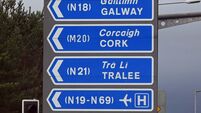Cost of borrowing for State rises sharply in past week

In recent weeks, the European Central Bank has pledged further rate hikes.
The cost of borrowing for the State along with other eurozone countries has risen significantly in the past week, reflecting market expectations that central banks will hike interest rates further next year than previously thought.
The implied cost of borrowing for the Government to borrow for 10 years rose by over a quarter point since last Friday, with the yield or interest rate on the Irish 10-year bond trading at 2.93%.
Nonetheless, the interest rate compares favourably with other countries in the eurozone, as well as that in Britain where the interest rate on its 10-year gilt or bond climbed by 0.30% to 3.63% in the past week.
The Irish 10-year yield continues to trade slightly lower than the 2.95% borrowing cost implied by the French 10-year bond, but is higher than the 2.40% borrowing cost for Germany.
Interest rates for the more indebted Italy and Greece also rose by a quarter point in the week, with their 10-year yields both trading at 4.52% on Friday. In recent weeks, the European Central Bank has pledged further rate hikes.
Data from the US this week point to a still tight labour market, triggering a bond selloff on both sides of the Atlantic. Traders will again be paying close attention to remarks from central bankers from early January.
"It's quite clear that financial markets and the ECB haven't been on the same page recently," said Massimiliano Maxia, senior fixed income specialist at Allianz Global Investors, mentioning the strong reaction to the ECB.
"Markets have been more focused on weak economic data and the risks that monetary policy would hurt the economy than just on inflation," he added.
Traders will also continue to focus on heavily indebted countries, such as Italy, which had benefitted most from low rates, before the ECB started on its hawkish rate increases this summer.
However, the closely watched spread or difference between the yields of the Italian and German 10-year bonds was little changed over the past week.
Investors said an ECB backstop could rein in the risk premium for southern European debt, but next year will provide a real test.
- Irish Examiner. Additional reporting Reuters












